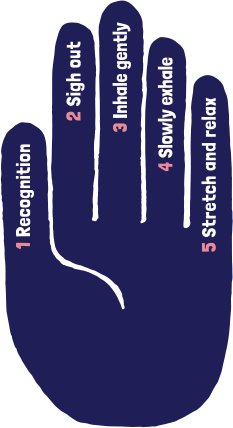Calming hand
The Calming Hand is a tool we use for teaching control of panic attacks. It also works well with episodes of breathlessness, whatever the cause. Its simplicity makes it very useful in helping you remember the main points of your coping strategy when you are actually experiencing panic or breathlessness. You should count the steps out on your fingers as an aide memoire.
Please download our resource below for more details on our Calming Hand technique.
 The Calming Hand is a tool we use for teaching control of panic attacks. It also works well with episodes of breathlessness, whatever the cause. Its simplicity makes it very useful in helping you remember the main points of your coping strategy when you are actually experiencing panic or breathlessness. You should count the steps out on your fingers as an aide memoire.
The Calming Hand is a tool we use for teaching control of panic attacks. It also works well with episodes of breathlessness, whatever the cause. Its simplicity makes it very useful in helping you remember the main points of your coping strategy when you are actually experiencing panic or breathlessness. You should count the steps out on your fingers as an aide memoire.
1 Recognition
Recognition of the signs of panic or breathlessness and that they are not sinister. Recognition of the need to put learned strategies into practice. You should hold the thumb firmly whilst reminding yourself of what to do next.
2 Sigh out
Simple instruction leads to complex reactions.
- Shoulders drop and muscles relax.
- The brain associates sighing out with relief or relaxing after effort or upset so sighing helps you to become calm.
- Sighing out ‘empties’ the lungs and makes room for you to breathe in fresh air.
- Sighing out will help to steady your heart rate and really helps if your heart tends to race.
3 Inhale gently
Take a slow and gentle relaxed breath in, focusing on filling your lungs with air.
4 Slowly exhale
Then, take a slow and gentle relaxed breath out, until your breath comes to its natural end. Relaxed breathing helps to relieve the sensation of breathlessness.
5 Stretch and relax
Stretching your muscles can really help you to relax when you are anxious or breathless, just stretch your fingers and wrists and then let them relax a few times – you can even do this in public.